faq
Wastewater is the polluted form of water generated from rainwater runoff and human activities. It is also called sewage. It is typically categorized by the manner in which it is generated—specifically, as domestic sewage, industrial sewage, or storm sewage
Sources of wastewater include homes, shops, offices and factories, farms, transport and fuel depots, vessels, quarries and mines.
Water used in toilets, showers, baths, kitchen sinks and laundries in homes and offices is domestic wastewater.
Wastewater from manufacturing and industrial operations such as food processing or metal refining is industrial or trade waste. This includes liquid waste from any process (e.g. water used to cool machinery or clean plant and equipment).
Water used in toilets, showers, baths, kitchen sinks and laundries in homes and offices is domestic wastewater.
Wastewater from manufacturing and industrial operations such as food processing or metal refining is industrial or trade waste. This includes liquid waste from any process (e.g. water used to cool machinery or clean plant and equipment).
Wastewater contains elements toxic to humans and the ecosystem. Wastewater treatment facilities help to purify the water and eliminate situations like what is currently seen in developing countries . Unclean water poses significant health risks, accounting for 1.7 million deaths annually, of which over 90% are in developing countries. Several water-related diseases, including cholera and schistosomiasis, remain widespread across many developing countries, where only a very small fraction (in some cases less than 5%) of domestic and urban wastewater is treated prior to its release into the environment.
Wastewater treatment also protects the ecosystem. Fish and aquatic life require fresh water. When their water environment is laden with wastewater, they cannot survive. If chemicals, such as nitrogen and phosphates, enter streams, rivers or large bodies of water in excessive amounts, it causes excessive plant growth which release toxins into the water. This leads to oxygen depletion and dead zones; areas where fish and other aquatic life can no longer exist.
Wastewater treatment also protects the ecosystem. Fish and aquatic life require fresh water. When their water environment is laden with wastewater, they cannot survive. If chemicals, such as nitrogen and phosphates, enter streams, rivers or large bodies of water in excessive amounts, it causes excessive plant growth which release toxins into the water. This leads to oxygen depletion and dead zones; areas where fish and other aquatic life can no longer exist.
Step 1: Screening and Pumping:
The incoming wastewater passes through screening equipment where objects such as rags, wood fragments, plastics, and grease are removed. The material removed is washed and pressed and disposed of in a landfill. The screened wastewater is then pumped to the next step: grit removal.

Step 2: Grit Removal: In this step, heavy but fine material such as sand and gravel is removed from the wastewater. This material is also disposed of in a landfill.
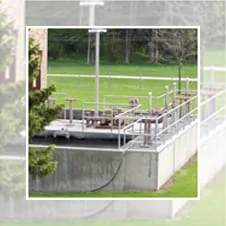
Step 3: Primary Settling: The material, which will settle, but at a slower rate than step two, is taken out using large circular tanks called clarifiers. The settled material, called primary sludge, is pumped off the bottom and the wastewater exits the tank from the top. Floating debris such as grease is skimmed off the top and sent with the settled material to digesters. In this step, chemicals are also added to remove phosphorus.
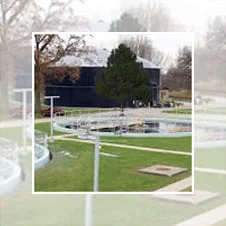
Step 4: Aeration / Activated Sludge: In this step, the wastewater receives most of its treatment. Through biological degradation, the pollutants are consumed by microorganisms and transformed into cell tissue, water, and nitrogen. The biological activity occurring in this step is very similar to what occurs at the bottom of lakes and rivers, but in these areas the degradation takes years to accomplish.
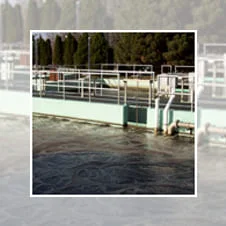
Step 5: Secondary Settling: Large circular tanks called secondary clarifiers allow the treated wastewater to separate from the biology from the aeration tanks at this step, yielding an effluent, which is now over 90% treated. The biology (activated sludge) is continuously pumped from the bottom of the clarifiers and returned to the aeration tanks in step four.
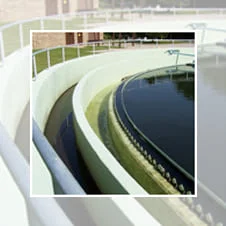
Step 6: Filtration: The clarified effluent is polished in this step by filtering through 10 micron polyester media. The material captured on the surface of the disc filters is periodically backwashed and returned to the head of the plant for treatment
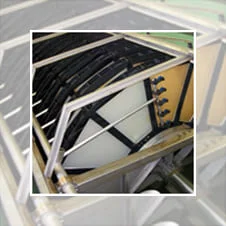
Step 7: Disinfection: The clarified effluent is polished in this step by filtering through 10 micron polyester media. The material captured on the surface of the disc filters is periodically backwashed and returned to the head of the plant for treatment.

Step 8: Oxygen Uptake: To assure the treated wastewater is virtually free of bacteria, ultraviolet disinfection is used after the filtration step. The ultraviolet treatment process kills remaining bacteria to levels within our discharge permit.
The treated water, now in a very stabilized high quality state, is aerated if necessary to bring the dissolved oxygen up to permit level. After this step, the treated water passes through the effluent outfall where it joins the Oconomowoc River. The water discharged to the river must meet stringent requirements set by the DNR. Pollutant removal is maintained at 98% or greater.
The treated water, now in a very stabilized high quality state, is aerated if necessary to bring the dissolved oxygen up to permit level. After this step, the treated water passes through the effluent outfall where it joins the Oconomowoc River. The water discharged to the river must meet stringent requirements set by the DNR. Pollutant removal is maintained at 98% or greater.
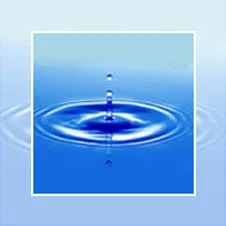
Step 9: Sludge Treatment: The primary sludge pumped from the bottom of the primary clarifiers in step three, along with the continuous flow of waste activated sludge from the aeration / activated sludge process in step four, must be treated to reduce volume and produce a usable end product.
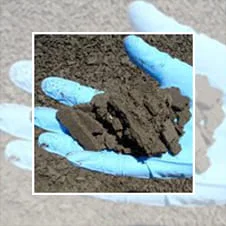
Physical Water Treatment:
In this stage, physical methods are used for cleaning the wastewater. Processes like screening, sedimentation and skimming are used to remove the solids. No chemicals are involved in this process.
One of the main techniques of physical wastewater treatment includes sedimentation, which is a process of suspending the insoluble/heavy particles from the wastewater. Once the insoluble material settles down at the bottom, you can separate the pure water.
Another effective physical water treatment technique includes aeration. This process consists of circulating air through the water to provide oxygen to it. Filtration, the third method, is used for filtering out all the contaminants. You can use special kind of filters to pass the wastewater and separate the contaminants and insoluble particles present in it. The sand filter is the most commonly used filter. The grease found on the surface of some wastewater can also be removed easily through this method.
Biological Water Treatment:
This uses various biological processes to break down the organic matter present in wastewater, such as soap, human waste, oils and food. Microorganisms metabolize organic matter in the wastewater in biological treatment. It can be divided into three categories:
Chemical Water Treatment:
As the name suggests, this treatment involves the use of chemicals in water. Chlorine, an oxidizing chemical, is commonly used to kill bacteria which decomposes water by adding contaminants to it. Another oxidizing agent used for purifying the wastewater is ozone. Neutralization is a technique where an acid or base is added to bring the water to its natural pH of 7. Chemicals prevent the bacteria from reproducing in water, thus making the water pure.
Sludge Treatment:
This is a solid-liquid separation process where the least possible residual moisture is required in the solid phase and the lowest possible solid particle residues are required in the separated liquid phase.
An example of this includes dewatering of sludge from industrial wastewater or sewage plant where the residual moisture in dewatered solids determines the disposal costs and the cent rate quality determines the pollution load returned back to the treatment facility. You need to minimize both.
In this stage, physical methods are used for cleaning the wastewater. Processes like screening, sedimentation and skimming are used to remove the solids. No chemicals are involved in this process.
One of the main techniques of physical wastewater treatment includes sedimentation, which is a process of suspending the insoluble/heavy particles from the wastewater. Once the insoluble material settles down at the bottom, you can separate the pure water.
Another effective physical water treatment technique includes aeration. This process consists of circulating air through the water to provide oxygen to it. Filtration, the third method, is used for filtering out all the contaminants. You can use special kind of filters to pass the wastewater and separate the contaminants and insoluble particles present in it. The sand filter is the most commonly used filter. The grease found on the surface of some wastewater can also be removed easily through this method.
Biological Water Treatment:
This uses various biological processes to break down the organic matter present in wastewater, such as soap, human waste, oils and food. Microorganisms metabolize organic matter in the wastewater in biological treatment. It can be divided into three categories:
- Aerobic processes: Bacteria decomposes the organic matter and converts it into carbon dioxide that can be used by plants. Oxygen is used in this process.
- Anaerobic processes: Here, fermentation is used for fermenting the waste at a specific temperature. Oxygen is not used in anaerobic process.
- Composting: A type of aerobic process where wastewater is treated by mixing it with sawdust or other carbon sources.
Chemical Water Treatment:
As the name suggests, this treatment involves the use of chemicals in water. Chlorine, an oxidizing chemical, is commonly used to kill bacteria which decomposes water by adding contaminants to it. Another oxidizing agent used for purifying the wastewater is ozone. Neutralization is a technique where an acid or base is added to bring the water to its natural pH of 7. Chemicals prevent the bacteria from reproducing in water, thus making the water pure.
Sludge Treatment:
This is a solid-liquid separation process where the least possible residual moisture is required in the solid phase and the lowest possible solid particle residues are required in the separated liquid phase.
An example of this includes dewatering of sludge from industrial wastewater or sewage plant where the residual moisture in dewatered solids determines the disposal costs and the cent rate quality determines the pollution load returned back to the treatment facility. You need to minimize both.
Primary treatment removes material that will either float or readily settle out by gravity. It includes the physical processes of screening, comminution, grit removal, and sedimentation. Screens are made of long, closely spaced, narrow metal bars. They block floating debris such as wood, rags, and other bulky objects that could clog pipes or pumps. In modern plants the screens are cleaned mechanically, and the material is promptly disposed of by burial on the plant grounds. A comminutor may be used to grind and shred debris that passes through the screens. The shredded material is removed later by sedimentation or flotation processes.
Grit chambers are long narrow tanks that are designed to slow down the flow so that solids such as sand, coffee grounds, and eggshells will settle out of the water. Grit causes excessive wear and tear on pumps and other plant equipment. Its removal is particularly important in cities with combined sewer systems, which carry a good deal of silt, sand, and gravel that wash off streets or land during a storm.
Suspended solids that pass through screens and grit chambers are removed from the sewage in sedimentation tanks. These tanks, also called primary clarifiers, provide about two hours of detention time for gravity settling to take place. As the sewage flows through them slowly, the solids gradually sink to the bottom. The settled solids—known as raw or primary sludge—are moved along the tank bottom by mechanical scrapers. Sludge is collected in a hopper, where it is pumped out for removal. Mechanical surface-skimming devices remove grease and other floating materials
Grit chambers are long narrow tanks that are designed to slow down the flow so that solids such as sand, coffee grounds, and eggshells will settle out of the water. Grit causes excessive wear and tear on pumps and other plant equipment. Its removal is particularly important in cities with combined sewer systems, which carry a good deal of silt, sand, and gravel that wash off streets or land during a storm.
Suspended solids that pass through screens and grit chambers are removed from the sewage in sedimentation tanks. These tanks, also called primary clarifiers, provide about two hours of detention time for gravity settling to take place. As the sewage flows through them slowly, the solids gradually sink to the bottom. The settled solids—known as raw or primary sludge—are moved along the tank bottom by mechanical scrapers. Sludge is collected in a hopper, where it is pumped out for removal. Mechanical surface-skimming devices remove grease and other floating materials
The residue that accumulates in sewage treatment plants is called sludge (or biosolids). Sewage sludge is the solid, semisolid, or slurry residual material that is produced as a by-product of wastewater treatment processes. This residue is commonly classified as primary and secondary sludge. Primary sludge is generated from chemical precipitation, sedimentation, and other primary processes, whereas secondary sludge is the activated waste biomass resulting from biological treatments. Some sewage plants also receive septage or septic tank solids from household on-site wastewater treatment systems. Quite often the sludges are combined together for further treatment and disposal.
Treatment and disposal of sewage sludge are major factors in the design and operation of all wastewater treatment plants. Two basic goals of treating sludge before final disposal are to reduce its volume and to stabilize the organic materials. Stabilized sludge does not have an offensive odour and can be handled without causing a nuisance or health hazard. Smaller sludge volume reduces the costs of pumping and storage.
Treatment and disposal of sewage sludge are major factors in the design and operation of all wastewater treatment plants. Two basic goals of treating sludge before final disposal are to reduce its volume and to stabilize the organic materials. Stabilized sludge does not have an offensive odour and can be handled without causing a nuisance or health hazard. Smaller sludge volume reduces the costs of pumping and storage.
Sludges can be disposed of by liquid injection to land or by disposal in a landfill.
There is no process which completely eliminates the need to dispose of treated sewage sludge.
Much sludge originating from commercial or industrial areas is contaminated with toxic materials that are released into the sewers from industrial or commercial processes or from domestic sources. Elevated concentrations of such materials may make the sludge unsuitable for agricultural use and it may then have to be incinerated or disposed of to landfill.
Despite the apparent unsuitability of at least some sewage sludge, application to farm-land remains a commonly used option
Aeration is used in municipal and industrial wastewater treatment processes. It is often the first major process in the treatment of wastewater. The submerged aeration diffusers release oxygen into the wastewater. Thus, as the bubbles rise from the bottom on the tank, oxygen moves from a gaseous state to a liquid state. This increases the dissolved oxygen and keeps microorganisms suspended. The longer these microorganisms remain suspended, the more efficient the process is in breaking down pollutants.
A wastewater treatment plant cleans the water so it can be safely returned to the environment. It removes various solids, which includes everything from rags and sticks to sand and smaller particles found in wastewater. It reduces organic material and pollutants by the controlled action of helpful bacteria and other microorganisms that consume organic matter in wastewater. The bacteria and microorganisms are then separated from the water and then disinfected. The process also restores oxygen to the water to ensure the water has enough oxygen to support life in our creeks, rivers, and lakes.


